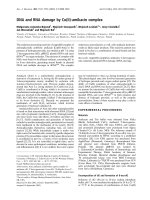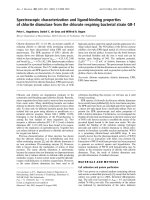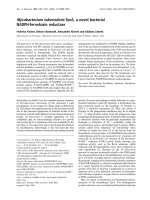Báo cáo y học: "My 2,000 best films: parallel phenotyping of Dictyostelium development" doc
Bạn đang xem bản rút gọn của tài liệu. Xem và tải ngay bản đầy đủ của tài liệu tại đây (54.64 KB, 3 trang )
Genome Biology 2007, 8:220
Minireview
My 2,000 best films: parallel phenotyping of Dictyostelium
development
Gareth Bloomfield*
†
and Robert R Kay*
Addresses: *MRC Laboratory of Molecular Biology, Hills Road, Cambridge CB2 OQH, UK.
†
The Wellcome Trust Sanger Institute, Hinxton
CB10 1SA, UK.
Correspondence: Robert R Kay. Email:
Abstract
A new study has used parallel filming to record the development of 2,000 Dictyostelium mutants,
and clustered them into related groups using morphological staging and wavelet analysis of
aggregation patterns.
Published: 23 July 2007
Genome Biology 2007, 8:220 (doi:10.1186/gb-2007-8-7-220)
The electronic version of this article is the complete one and can be
found online at />© 2007 BioMed Central Ltd
Genetic screens have driven progress in molecular biology
from its earliest days. Think of the fine structure of the gene
as studied in phage T4 [1], the delineation of cell-cycle genes
in yeast [2] and the identification of genes underlying
development in Drosophila [3]. Such screens always require
ingenuity of inception but, especially in metazoa, they also
require skill and patience to carry out. Screens for mutants
in the fly eye have revealed many important aspects of
growth factor signaling, but they required a breeding program
to produce randomly mutated individuals and then skilled
microscopic observation of the compound eyes to identify
aberrant patterns of differentiation. It is therefore not
surprising that it has been difficult to increase the
productivity of such screens to match that of genome
sequencing and other genomic methods.
This situation is slowly changing. For instance, RNA
interference (RNAi) or directed gene deletion can replace
traditional mutagenesis, with the advantage that saturation
of the genome is approached directly rather than asymp-
totically and the identity of the mutated genes is known from
the outset. Coupled to this, automated microscopy and
image analysis allows enormous amounts of data to be
accumulated and analyzed from mutant individuals. For
example, near-complete collections of gene-deletion
mutants have been amassed and studied in parallel in
budding yeast [4,5], gene expression has been systematically
perturbed by RNAi and the consequences captured by
time-lapse filming in Caenorhabditis elegans [6], and defects
in mitotic progression in cultured carcinoma cells have been
screened for using RNAi and automated image analysis [7].
Traditional genetic screens succeeded best where they could
pick out mutants affecting the process of interest and reject
others. But if sufficient data can be gathered, and appro-
priately clustered, then it may be possible to perform a single
comprehensive screen from which many different classes of
mutants can be recognized. In a paper published in Genome
Biology [8], Sawai and colleagues report a screen for
developmental mutants of the social amoeba Dictyostelium
discoideum, based on parallel time-lapse filming, which
moves in this direction.
The particularities of Dictyostelium
Dictyostelium brings particular biological advantages to
such an enterprise, due to its ease of culture and genetic
manipulation [9,10]. Its genome is compact and has been
fully sequenced, with around 12,500 genes [11]. Positioned
among the crown group of eukaryotes, it is notable for
having many genes in common with metazoans that have
been lost from yeast. An alternative set of cell biological
problems is addressable compared with yeast, including cell
motility and chemotaxis, phagocytosis and extensive
intercellular communication. Its position on the border
between unicellular and multicellular life also makes
Dictyostelium particularly interesting for studies on the
evolution of multicellularity and the consequent appearance
of altruistic cell types (in this case dead stalk cells), which
also brings the necessity of avoiding cheating [12].
In the wild, Dictyostelium grows as individual amoebae that
feed on bacteria, but domesticated versions can grow in
defined media. In both cases, depletion of food provokes a
remarkable social behavior: the previously individualistic
cells organize themselves into multicellular aggregates by
chemotaxis guided by cyclic AMP. After a few hours of
starvation, a few cells spontaneously release cyclic AMP,
which diffuses towards their immediate neighbors. These
respond by chemotaxis towards the cyclic AMP source - the
aggregation center - and themselves release a pulse of cyclic
AMP, which diffuses towards and attracts more distant cells,
and so on. The periodic waves of cyclic AMP traversing the
field of amoebae can be visualized microscopically by the
cellular responses of rounding and elongation that they elicit
as they pass over responsive cells. The truly multicellular
aggregates thus formed then undergo a programmed series
of morphological changes, including directed migration
across the substratum to a suitable place to fruit, and
ultimately the formation of a fruiting body or sorocarp,
consisting of a slender stalk supporting a mass of spores.
The spores can then be dispersed to locations where growth
can recommence.
Parallel time-lapse filming of Dictyostelium
development
Sawai and colleagues [8] used a robotic gantry camera system
to film the development of up to 100 mutant clones in
parallel. The aggregation waves of early development could
be visualized after image processing and were characterized
using wavelet analysis [13]. This analytical tool uses
mathematical functions to capture important periodic
features within data. Wavelet transforms follow similar
principles to Fourier transforms, with the important
difference that they are particularly suited to local, evolving
patterns in data. Later stages of development were scored
morphologically, with qualitative phenotypes fitted into a
coarse quantitative scale. The whole dataset could then be
clustered to give a number of groupings of mutants that make
biological sense. For instance, strains mutant in genes in a
histidine kinase phosphorelay system that regulates
intracellular cyclic AMP levels clustered together, as did
strains mutant in a number of genes required at the initiation
of development.
Sawai et al. [8] report that using this method they found that
about 4% of the mutants analyzed were found to have a clear
developmental defect, although they grew normally as
individual amoebae. This makes one wonder about the other
96%, which showed no phenotypic defects in this assay.
These mutants were created by insertion of a single plasmid
anywhere in the genome [14], although with some bias
towards insertion into coding sequences. Many insertions
may be in unimportant intergenic regions and literally have
no phenotype; other insertions will be in redundant genes.
Some mutants will affect growth, but not in the conditions
used; others may have subtle developmental phenotypes
undetected in this analysis; and yet others may affect
processes that were not assayed by this screen. For instance,
Dictyostelium can form resistant cells called aspidocytes in
response to toxic attack [15], and forms macrocysts as part of
its sexual cycle [16]. It also appears well equipped for
ecological interaction by production of polyketide signals
and antibiotics, but none of these aspects of its life-style
would be expected to be elicited in the conditions studied by
Sawai et al. [8].
Expanding the horizon
Apart from widening the range of experimental conditions
examined, the application of parallel filming can be
expanded in several directions. First, and most obvious, it
will be desirable to saturate the protein-coding potential of
the genome with mutations. Genes nonessential for normal
growth can be examined for possible developmental
functions in loss-of-function mutants. The analysis system of
Sawai et al. [8] clearly has the capacity to do this, but the
production of mutants will become limiting as saturation is
approached, and it will be necessary to switch from the
current random plasmid-insertion methods to directed gene
knockout to play the end-game efficiently. The remaining
essential genes can, in principle, be studied using partial
loss-of-function alleles created using RNAi to knock down
expression [17].
The dynamics of the cyclic AMP oscillator in aggregation
have been modeled previously [13,18], but the wealth of
quantitative data now available from the study of Sawai et al.
[8], and the identification of further genes affecting this
oscillator should enable these models to be put on a more
realistic biological basis. Connection of the film data [8] to
the Dictyostelium database [19], which is under way, will
make this information readily available.
Finally, the parallel-filming approach is ideal for screening
drugs and inhibitors. One bottleneck in the procedure of
Sawai et al. [8] is the growth and preparation for
development of so many strains. For drug screening, it
would be possible to use just a single strain - the wild type or
a sensitized mutant, mutated in the process of interest to
render them more sensitive to additional mutations in the
same process - and then use the technique to determine the
effects of adding known drugs and chemical libraries in
parallel. Similar clustering and classification methods to
those used by Sawai et al. [8] could be applied to the data
and genetic phenotypes matched to chemical ones, thus
giving a direct insight into the target of the drug.
220.2 Genome Biology 2007, Volume 8, Issue 7, Article 220 Bloomfield and Kay />Genome Biology 2007, 8:220
References
1. Benzer S: On the topology of the genetic fine structure. Proc
Natl Acad Sci USA 1959, 45:1607-1620.
2. Hartwell LH, Culotti J, Pringle JR, Reid BJ: Genetic control of the
cell division cycle in yeast. Science 1974, 183:46-51.
3. Nusslein-Volhard C, Wieschaus E: Mutations affecting segment
number and polarity in Drosophila. Nature 1980, 287:795-801.
4. Winzeler EA, Shoemaker DD, Astromoff A, Liang H, Anderson K,
Andre B, Bangham R, Benito R, Boeke JD, Bussey H, et al.: Func-
tional characterization of the S. cerevisiae genome by gene
deletion and parallel analysis. Science 1999, 285:901-906.
5. Giaever G, Chu AM, Ni L, Connelly C, Riles L, Veronneau S, Dow S,
Lucau-Danila A, Anderson K, Andre B, et al.: Functional profiling
of the Saccharomyces cerevisiae genome. Nature 2002, 418:387-
391.
6. Kamath RS, Fraser AG, Dong Y, Poulin G, Durbin R, Gotta M,
Kanapin A, Le Bot N, Moreno S, Sohrmann M, et al.: Systematic
functional analysis of the Caenorhabditis elegans genome
using RNAi. Nature 2003, 421:231-237.
7. Moffat J, Grueneberg DA, Yang X, Kim SY, Kloepfer AM, Hinkle G,
Piqani B, Eisenhaure TM, Luo B, Grenier JK, et al.: A lentiviral
RNAi library for human and mouse genes applied to an
arrayed viral high-content screen. Cell 2006, 124:1283-1298.
8. Sawai S, Guan X-J, Kuspa A, Cox EC: High-throughput analysis
of spatio-temporal dynamics in Dictyostelium. Genome Biol
2007, 8:R144.
9. Kay RR, Williams JG: The Dictyostelium genome project: an
invitation to species hopping. Trends Genet 1999, 15:294-297.
10. Kessin RH: Dictyostelium. Cambridge: Cambridge University Press;
2001.
11. Eichinger L, Pachebat JA, Glockner G, Rajandream MA, Sucgang R,
Berriman M, Song J, Olsen R, Szafranski K, Xu Q, et al.: The
genome of the social amoeba Dictyostelium discoideum.
Nature 2005, 435:43-57.
12. Foster KR, Shaulsky G, Strassmann JE, Queller DC, Thompson CR:
Pleiotropy as a mechanism to stabilize cooperation. Nature
2004, 431:693-696.
13. Sawai S, Thomason PA, Cox EC: An autoregulatory circuit for
long-range self-organization in Dictyostelium cell popula-
tions. Nature 2005, 433:323-326.
14. Kuspa A, Loomis WF: Tagging developmental genes in Dic-
tyostelium by restriction enzyme-mediated integration of
plasmid DNA. Proc Natl Acad Sci USA 1992, 89:8803-8807.
15. Serafimidis I, Bloomfield G, Skelton J, Ivens A, Kay RR: A new envi-
ronmentally resistant cell type from Dictyostelium. Microbiol-
ogy 2007, 153:619-630.
16. Urushihara H, Muramoto T: Genes involved in Dictyostelium dis-
coideum sexual reproduction. Eur J Cell Biol 2006, 85:961-968.
17. Martens H, Novotny J, Oberstrass J, Steck TL, Postlethwait P, Nellen
W: RNAi in Dictyostelium: the role of RNA-directed RNA
polymerases and double-stranded RNase. Mol Biol Cell 2002,
13:445-453.
18. Martiel JL, Goldbeter A: Autonomous chaotic behaviour of the
slime mould Dictyostelium discoideum predicted by a model
for cyclic AMP signaling. Nature 1985, 313:590-592.
19. dictyBase []
Genome Biology 2007, Volume 8, Issue 7, Article 220 Bloomfield and Kay 220.3
Genome Biology 2007, 8:220








